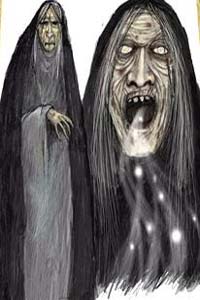
In Albania, the shtriga is a female witch whose special prey is infants. At least as late as the early twentieth century, the shtriga was blamed for otherwise unexplained infant deaths as well as adult’s death but to a lesser extent.
At night, she often sought her prey in the form of an insect such as a moth, a fly, or a bee. One way to create a charm to protect against the shtriga is to follow a shtriga in her natural human form at night. Eventually she will vomit some of the blood she had drank from her victims. According to the belief, if you scrape up some of this vomit onto a silver coin, wrap the coin in cloth, and wear it always, no shtriga can harm you.
The shtriga usually lives incognito in a community. She even goes to church for the regular services. She could be detected during such a service by passing out bread spiced with garlic. A shtriga will always refuse to eat anything containing garlic.
The second way is to place a cross of pig bone on the doors of the church after everyone in the community has gathered inside. Everyone but a shtriga will be able to leave the church through these doors.
Most of what we know about shtriga is from two written works by Edith Durham who traveled through Albania and other Balkan countries: her book High Albania (first published in 1909; reprinted by Virago Press Ltd. in 1985) and her article “Of Magic, Witches and Vampires in the Balkans” in the journal Man (December, 1923) published in England by the Royal Anthropological Institute.








